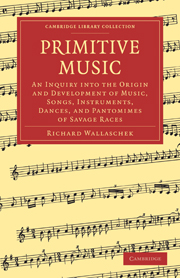 Primitive Music
Primitive Music Book contents
- Frontmatter
- PREFACE
- Contents
- CHAPTER I GENERAL CHARACTER OF THE MUSIC OF PRIMITIVE PEOPLE
- CHAPTER II SINGERS AND COMPOSERS IN PRIMITIVE TIMES
- CHAPTER III INSTRUMENTS
- CHAPTER IV THE BASIS OF OUR MUSICAL SYSTEM
- CHAPTER V PHYSICAL AND PSYCHICAL INFLUENCE OF MUSIC
- CHAPTER VI TEXT AND MUSIC
- CHAPTER VII DANCE AND MUSIC
- CHAPTER VIII PRIMITIVE DRAMA AND PANTOMIME
- CHAPTER IX ORIGIN OF MUSIC
- CHAPTER X HEREDITY AND DEVELOPMENT
- Summary
- List of quoted Authorities
- Index
- Plate section
CHAPTER IV - THE BASIS OF OUR MUSICAL SYSTEM
Published online by Cambridge University Press: 29 August 2010
- Frontmatter
- PREFACE
- Contents
- CHAPTER I GENERAL CHARACTER OF THE MUSIC OF PRIMITIVE PEOPLE
- CHAPTER II SINGERS AND COMPOSERS IN PRIMITIVE TIMES
- CHAPTER III INSTRUMENTS
- CHAPTER IV THE BASIS OF OUR MUSICAL SYSTEM
- CHAPTER V PHYSICAL AND PSYCHICAL INFLUENCE OF MUSIC
- CHAPTER VI TEXT AND MUSIC
- CHAPTER VII DANCE AND MUSIC
- CHAPTER VIII PRIMITIVE DRAMA AND PANTOMIME
- CHAPTER IX ORIGIN OF MUSIC
- CHAPTER X HEREDITY AND DEVELOPMENT
- Summary
- List of quoted Authorities
- Index
- Plate section
Summary
When at the beginning of the last century Kolbe travelled among the Hottentots he found them playing different gom-goms in harmony. They also sang the notes of the common chord down to the lower octave, each one beginning with the phrase whenever the former had already come to the second or third tone, thus producing a harmonious effect. The words to this song were simply “ho, ho, ho”. Burchell, who repeatedly assures us that he probably was the first European who ever touched the African soil in that part where he travelled, describes the harmonious singing of the Bachapin boys [Mus. Ex. 14]: sometimes one of them led the band and the rest joined in at different intervals, and, guided only by the ear, attuned their notes in correct harmony. The elder boys, whose voices were of a lower pitch, sang the bass, while the younger produced, in their turn, the higher tones of the treble. The Bechuana also sing in harmony. The melody of their songs is simple enough, consisting chiefly of descending and ascending by thirds, while the singers have a sufficient appreciation of harmony to sing in two parts. Moodie tells us that he very often heard the Hottentot servant girls singing in two parts; they even sang European tunes which were quite new to them with the accompaniment of a second of their own. The same is said by Soyaux of the negro girls in Sierra Leone. We need not trace European influence in these instances, for the girls had neither been taught to sing the second voice nor had they heard it, but made it of their own accord.
- Type
- Chapter
- Information
- Primitive MusicAn Inquiry into the Origin and Development of Music, Songs, Instruments, Dances, and Pantomimes of Savage Races, pp. 139 - 162Publisher: Cambridge University PressPrint publication year: 2009First published in: 1893


